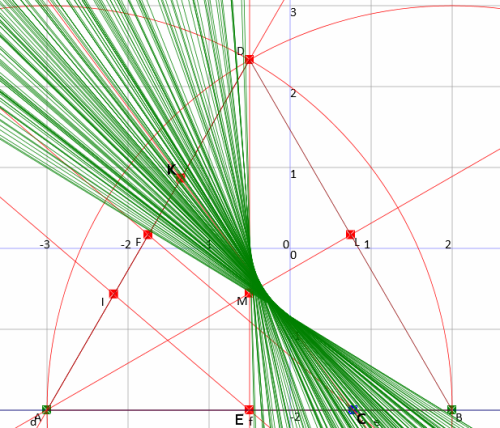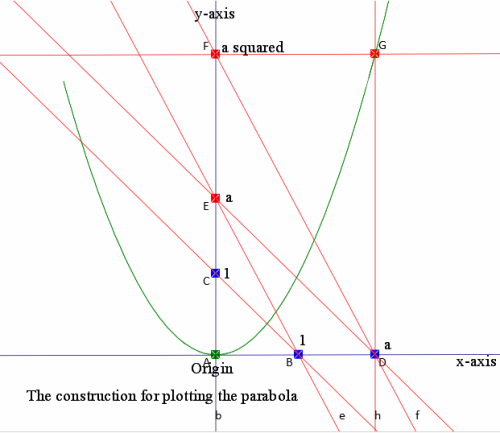This all started with a post by Maya Quinn (mathwater.wordpress.com) on problem solving. An oblong piece has been removed from an oblong cake (why? who did that?).The problem was to cut the remainder of the cake into two equal parts. Lots of solutions, one in particular was very imaginative.
This led me to another problem – what if the cut-out piece was triangular?
In view of one of the solutions to the first problem I decided that the triangle should be chopped in half. Not as simple as chopping a rectangle in half !

So, with Polya at my side (he’s been there since 1962) I decided that an equilateral triangle would be a reasonable starting point, as at least it was obvious that there were a few lines through the centroid doing the job (the medians), so some generality was still around.
Here is the equilateral triangle, nicely resting on the x axis, side length 2, top point on the y axis.

The vertical median bisects the triangle, so I described the general bisector GH by the distances x=DG and y=EH
In order to find out more about the bisector lines I first found a relationship between x and y, which was y=2x/(1+x), based on the area calculations:
Height of equilateral triangle is √3, base is 2, so area is √3
Height of BGH triangle is (2-y)/2 * √3, base is 1+x, so area is (1/2)*(1+x)*(2-y)/2*√3
and this is to be half of √3
So (1/2)*(1+x)*(2-y) must be equal to 1, and this leads to y=2x/(1+x)
This allowed me to find the coordinates of the point H and locate it correctly on the line.
I then joined the points and by moving G the line moved, and I tracked it, shown in green below.
Small notational irritation: In the diagram below G is now C and H is now K

The visible curve is called the envelope of the lines, and it (obviously) touches the medians.
The complete envelope of the bisecting lines consists of two more sections, making a “concave”triangle with the centroid in the middle.
At this point I figured that a change of variable was in order, and looking at the y=2x/(1+x) equation, and at the diagram it looked like the distances of the two points from the left hand vertex would be helpful:
This produced X=1+x and Y=2-y, and to my surprise the resulting equation was Y=2/X, or XY=2.
The significance of this last equation escaped me at this point.
So I found the coordinates of the two points C and K in a coordinate system with origin at point A, in terms of the new variables X and Y, found the line joining them, rewrote in terms of a parameter P, used a bit of calculus to get the envelope (I’ll do a post on this later), and it had the second degree equation
√3/4 = y2 – √3y – √3xy + 3x
which is a hyperbola !!! (see C. Smith “Conic Sections”)
At this point I stopped thinking about halving a triangle, and looked at the full envelope for one of the three sections, and got this:

A complete hyperbola, and, not only that, its asymptotes appear to be sides of the equilateral triangle. (Which when you think about it is not completely unreasonable !).
Then, thinking about doing shear operations on the picture, and with the X, Y variables, and ratios of lengths of segments on the same line being unchanged, I constructed the whole lot on an arbitrary triangle and did the envelope:

The triangle is ADF and the halving line is BG. Yes ! Same result !
At which point I saw a bit of light, and thought that “XY=2” does not involve angles at all.
Ooops, there’s another formula for the area of a triangle: a*b*sin(C)/2
Then straightaway all was revealed. You can draw the picture !
1. Triangle ACB, point X on side AC, point Y on side BC, area=0.5*AC*BC*sin(ACB)
2. Triangle XCY, area 0.5*XC*YC*sin(XCY), but angles ACB and XCY are the same, so if we require the area of triangle XCY to be half the area of triangle ACB we get 0.5*XC*YC*sin(XCY)=0.5*0.5*AC*BC*sin(ACB)
which reduces to (XC/AC)*(YC/BC)=0.5, and this does not involve the angle.
This corresponds to our earlier XY=2 since the equilateral triangle had side length 2
Pure speculation suggests that this result may have some connection with the way that the angle bisector of an angle in a triangle divides the opposite side in the ratio of the two adjacent sides.
———————————————–
The geometric diagrams were all constructed with the web based program
http://www.mathcomesalive.com/geostruct/geostructforbrowser1.html
√3

 Constructions done with my web based program. Try it yourself: GEOSTRUCT
Constructions done with my web based program. Try it yourself: GEOSTRUCT











